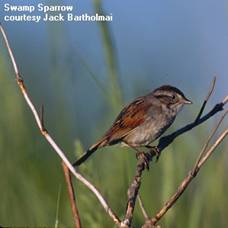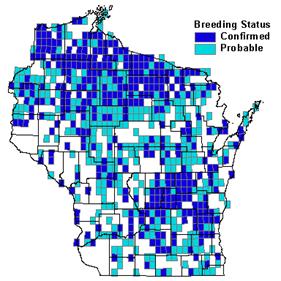

Status/Protection
- Global Rank: G5 Key to global and state ranks
- State Rank: S4B
- WBCI Priority: PIF
Population Information
The Federal BBS information can be obtained at http://www.mbr-pwrc.usgs.gov/bbs/bbs.html by clicking on Trend Estimates and selecting the species in question. All estimates are for time period (1966-2005).
- Federal Breeding Bird Survey: significant increase
- Federal Breeding Bird Survey (WI): significant increase
- Federal Breeding Bird Survey (BCR 23): significant increase
- Federal Breeding Bird Survey (BCR 12): significant increase
- Chequamegon National Forest Bird Survey (NRRI): non-significant decline (1992-2005)
- WSO Checklist Project: stable (1983-2007)
Life History
- Breeding Range: Eastern British Columbia to Newfoundland south to Nebraska to coastal Maryland (Mowbray 1997).
- Breeding Habitat: Emergent Marsh, Northern Sedge Meadow and Marsh, Southern Sedge Meadow and Marsh, Open Bog-Muskeg, Forested Ridge and Swale.
- Nest: Bulky cup; slightly elevated over ground or water (Mowbray 1997).
- Nesting Dates: Eggs: early May to early August (Robbins 1991).
- Foraging: Ground glean (Ehrlich et al. 1988).
- Migrant Status: Short-distance migrant, Neotropical migrant.
- Habitat use during Migration: Similar to breeding habitat; also uses old field, brushy growth, farm hedgerows, pastures, blackberry thickets, and residential shrubbery (Mowbray 1997).
- Arrival Dates: Early April to mid-May (Robbins 1991).
- Departure Dates: Early September to late October (Robbins 1991).
- Winter Range: South to central Mexico (Ehrlich et al. 1988), but regularly present in Wisconsin north to Crawford, Dodge, and Sheboygan counties (Robbins 1991).
- Winter Habitat: Similar to breeding habitat.
Habitat Selection
Swamp Sparrows occur in a wide variety of wetland habitats including cattail marshes, shrubby wetlands, sedge meadows, and open wooded swamps (Schultz 2006). In the Chequamegon-Nicolet National Forest, Swamp Sparrows have been detected in alder, pole-size black spruce-tamarack, and regenerating hardwood stands (Danz et al. 2007). Within these habitats, plant structure (Benoit and Askins 2002) and the presence of water appear to be important habitat requirements. Shallow standing water may be important for foraging (Mowbray 1997). A study conducted in Connecticut suggested that Swamp Sparrows are not area-sensitive (Benoit and Askins 2002) but further studies are needed to verify this elsewhere in their range. Nests are typically <1 meter in height and located above ground or over shallow water (Mowbray 1997, K. Coates, pers. comm.).
Habitat Availability
Prior to Euro-American settlement, wetlands occupied an estimated four million hectares of the total fourteen million hectares of Wisconsin’s land area. Today, 2.1 million hectares (53%) of these wetland habitats remain, mostly in the northern third of the state. Strict wetland use regulations and incentive programs designed to restore or enhance wetlands have helped to curb habitat loss and protect existing wetlands (WDNR 1995). Agricultural drainage and urban development remain threats to wetland ecosystems and local populations of wetland-associated birds. Human activities that alter hydrology and introduce invasive plant species also threaten wetland habitats (WDNR 2003).
Population Concerns
Breeding Bird Survey (BBS) data suggest that Swamp Sparrow populations are increasing range-wide and in Wisconsin (Sauer et al. 2005). They are common to fairly common summer residents throughout the state, and during the Wisconsin Breeding Bird Atlas (1995-2000), observers confirmed breeding activity in 31% of the surveyed quads (Schultz 2006).
Continued loss and alteration of wetland habitats remains a threat to this species. Because Swamp Sparrows commonly place their nests over water, fluctuations in water levels may flood nests and impact reproductive success in floodplain-associated wetlands (Mowbray 1997).
Recommended Management
Preservation of expansive wetlands should be a primary management strategy. The continuation of wetland management, protection, and restoration efforts such as the Wetland Reserve Program, Partner for Fish and Wildlife program, and North American Wetland Conservation Act will benefit this species. Management efforts directed at waterfowl and other wetland-associated species also should benefit Swamp Sparrows (Mowbray 1997).
Research Needs
Population densities are needed from a broad geographic area and wide range of habitats. Further study on habitat selection would help guide future management efforts. More research on non-breeding populations (e.g., general food habits, competition for resources, social structure) is needed (Mowbray 1997).
Information Sources
- Chequamegon National Forest Bird Survey (NRRI) species account: http://www.nrri.umn.edu/mnbirds/accounts/SWSPa2.htm
- Cornell Lab of Ornithology species account: http://www.birds.cornell.edu/AllAboutBirds/BirdGuide/Swamp_Sparrow.html
- Nicolet National Forest Bird survey map: http://www.uwgb.edu/birds/nnf/species/SWSP.htm
- North American Breeding Bird Survey: http://www.mbr-pwrc.usgs.gov/bbs/bbs.html
- Patuxent Bird Identification Center: http://www.mbr-pwrc.usgs.gov/id/framlst/i5840id.html
- Temple S.A., J.R. Cary, and R. Rolley. 1997. Wisconsin Birds: A Seasonal and Geographical Guide. Wisconsin Society of Ornithology and Wisconsin Department of Natural Resources, Madison, WI.
- Wisconsin Breeding Bird Atlas: http://www.uwgb.edu/birds/wbba/
References
- Benoit, L.K. and R.A. Askins. 2002. Relationship between habitat area and the distribution of tidal marsh birds. Wilson Bulletin 114(3): 314-323.
- Danz, N.P., G.J. Niemi, J. Lind, and J.M. Hanowski. 2007. Birds of Western Great Lakes Forests. http://www.nrri.umn.edu/mnbirds/
- Ehrlich, P.R., D.S. Dobkin, and D. Wheye. 1988. The birders handbook: a field guide to the natural history of North American birds. Simon & Schuster, Inc. New York.
- Mowbray, T.B. 1997. Swamp Sparrow (Melospiza georgiana). In The Birds of North America, No. 509, (A. Poole and F. Gill, eds.). The Birds of North America, Inc. Philadelphia, PA.
- Schultz, T.R. 2006. Swamp Sparrow. In Atlas of the Breeding Birds of Wisconsin. (N.J. Cutright, B.R. Harriman, and R.W. Howe, eds.) The Wisconsin Society for Ornithology, Inc. 602pp.
- Robbins, S.D., Jr. 1991. Wisconsin birdlife: population and distribution past and present. Madison, WI: Univ. Wisconsin Press.
- Sauer, J.R., J.E. Hines, and J. Fallon. 2005. The North American Breeding Bird Survey, Results and Analysis 1966 - 2005. Version 6.2.2006. USGS Patuxent Wildlife Research Center, Laurel, MD.
- Wisconsin Department of Natural Resources (WDNR). 1995. Wisconsin’s Biodiversity as a Management Issue. http://dnr.wi.gov/org/land/er/biodiversity/report.htm
- Wisconsin Department of Natural Resources (WDNR) Wetland Management Team. 2003. Reversing the loss: A strategy for protecting and restoring wetlands in Wisconsin. Wisconsin Department of Natural Resources, Madison, WI. http://dnr.wi.gov/org/water/fhp/wetlands/documents/reversing.pdf
Contact Information
- Compiler: Kim Kreitinger, K.Kreitinger@gmail.com
- Editor: Andy Paulios, Andy.Paulios@Wisconsin.gov
